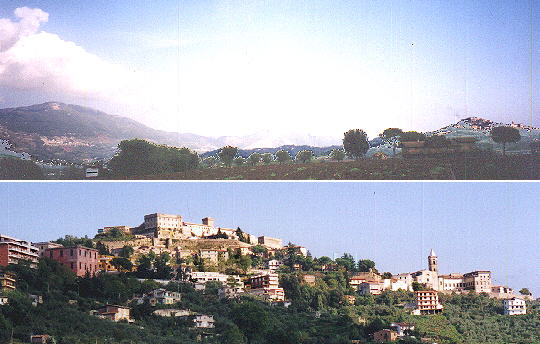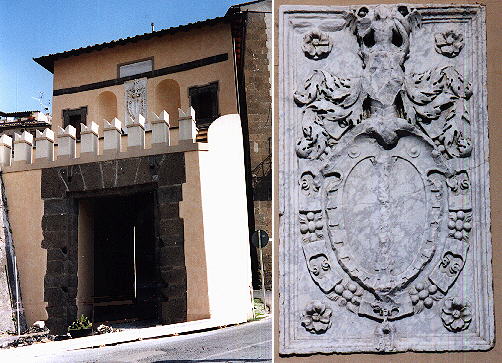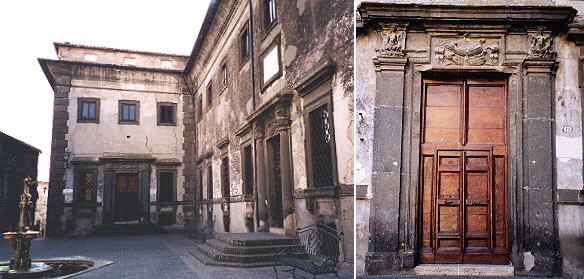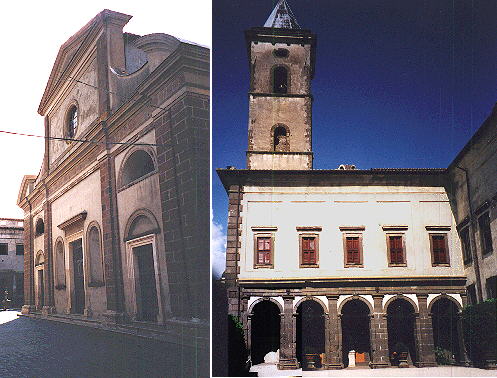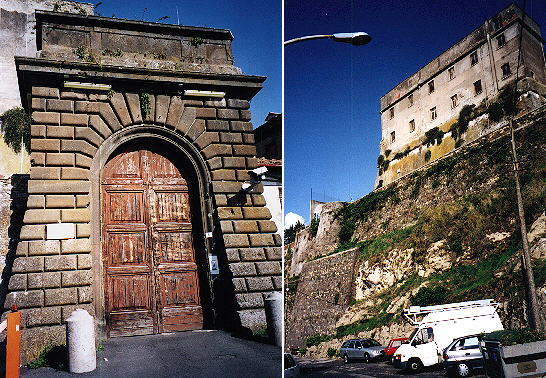  Ferdinand Gregorovius' Walks - Paliano
Gregorovius rides with a servant from Genazzano to Paliano and Anagni.
Paliano is visible from Genazzano and Gregorovius enjoys the ride in the countryside. On the hills
on the left side he sees other little towns: Olevano, Bellegra and Serrone.
View of Paliano
Paliano is dominated by the fortress and the palace of the Colonna. Gregorovius enters Paliano from Porta Romana: the coat of arms
of Paliano is the coat of arms of the Colonna as you can see in the image I used as a background
for this page: the streets are named after the Colonna and you obviously find a
Taverna Colonna.
The Colonna palace was modified by Antonio del Grande in the second half of the XVIIth century. The Colonna di Paliano did not hesitate to fight against the pope. In particular they fought for Paliano against Paulus IV in 1556: it was a veritable war called Guerra di Campagna and the Colonna were supported by Spain. The nephew of Paulus IV, Don Giovanni Carafa, became for a few years the Duke of Paliano. His beautiful wife, Dona Violante di Cardona, was the Duchesse de Paliano celebrated in a short novel by Stendhal. At the death of Paulus IV, Marcantonio Colonna regained all his possessions. He regarded himself almost as a sovereign: when Pius V in 1571 launched an appeal to the catholic nations to form a coalition to fight against the Turks, he responded in such a massive way to be among the commanders of the fleet which defeated the Turkish navy at Lepanto in the Gulf of Corinth. Thus, the street leading to the palace is Via Lepanto and the entrance to the palace is embellished with naval references.
The fame acquired by Marcantonio Colonna is celebrated in the family palace in Rome, but the expenses incurred by Marcantonio were so high that in order to pay the debt his heirs had to sell many properties to the Borghese, the Barberini and the Pamphily. The church of Sant'Andrea has a chapel built in the XVIIth century where the Colonna are buried, but the lack of money did not allow for any expensive decoration.
The fortress was sold to the Papal State in the XIXth century and became (and still is) a prison.
After visiting the palace, Gregorovius and his servant move on towards Anagni. Next page Introductory page on Ferdinand Gregorovius Palestrina Genazzano Anagni Other walks: The Ernici Mountains: Ferentino Alatri The Volsci Mountains: Valmontone Segni Norma Cori On the Latin shores: Anzio Nettuno and Torre Astura Circe's Cape: Terracina San Felice The Orsini Castle in Bracciano Subiaco, the oldest Benedictine monastery See my Home Page on Baroque Rome or my Home Page on Rome in the footsteps of an XVIIIth century traveller. |
All images © 1999 - 2003 by Roberto Piperno. Write to romapip@quipo.it
